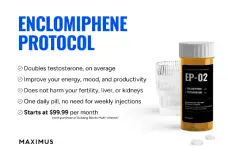madman
Super Moderator
* In men with TD, lower LH levels and higher TT levels were a predictors of CC response. Clinicians can incorporate this into their treatment discussions with patients with TD.

PREDICTORS OF CLOMIPHENE CITRATE RESPONSE IN THETREATMENT OF MEN WITH TESTOSTERONE DEFICIENCY
Daniel J. Kim*, Melissa Assel, Nicole Liso, Ahmed Elshafei,Andrew J. Vickers, John P. Mulhall, Jose M. Flores, New York, NY
INTRODUCTION AND OBJECTIVE
Clomiphene citrate (CC) has proven efficacy in managing testosterone deficiency (TD) in men. This study aimed to identify predictors of a clinically meaningful response in serum total testosterone (TT) levels when using CC as treatment.
METHODS
This study included symptomatic men with (i) low TT (≤300 ng/dL) (ii) or borderline TT (≤400 ng/dL) with signs of TD such as low bone density or new discovery of elevated HbA1c. Two morning TT measurements were measured using liquid chromatography-mass spectrometry. Initial CC dose was 25 mg every other day (QOD). Follow-up labs were obtained 3-12 weeks after initiation. Adequate response was defined as an on-treatment TT level≥400 ng/dL. CC was increased to 50 mg QOD in those with poor response. No response within 12 weeks or a switch to alternate therapy prior to response was considered treatment failure. A secondary analysis was performed with adequate response being defined as a rise in TT>200 ng/dL from baseline. Multivariable logistic regression was used to identify predictors of treatment success including age, comorbidities, smoking status, baseline TT and LH, concurrent anastrozole, prior androgen deprivation, prior chemotherapy, prior radiation, and prior radical prostatectomy.
RESULTS
292 men met the inclusion criteria for this study with a median age of 60 (IQR 50,66) years. 52 patients met criteria but were excluded due to lack of compliance for post-treatment lab work. Comorbidities: 18% diabetes, 46% hyperlipidemia, 44% hypertension, 41% had radical prostatectomy, 12% pelvic radiotherapy, and 5% prior androgen deprivation therapy. Median baseline TT was 264 (IQR 219, 314) ng/dL and luteinizing hormone (LH) was 3.5 (IQR 2.6, 5.1) mU/mL. 67% (CI 61-72%) responded with an on-treatment TT>400 ng/dL. 49% (CI 43%-55%) had a response of>200 ng/dL above baseline. On multivariate models, baseline TT (OR 1.18, CI 1.13-1.25, p<0.001) and baseline LH (OR 0.53, CI 0.63-0.90, p=0.003) were predictive of an on-treatment TT>400 ng/dL. Baseline LH remained negatively predictive when response was defined as a rise>200 ng/dL above baseline. The figure graphically represents multivariate models for the probability of success based on baseline TT and LH.
CONCLUSIONS
In men with TD, lower LH levels and higher TT levels were a predictors of CC response. Clinicians can incorporate this into their treatment discussions with patients with TD.
PREDICTORS OF CLOMIPHENE CITRATE RESPONSE IN THETREATMENT OF MEN WITH TESTOSTERONE DEFICIENCY
Daniel J. Kim*, Melissa Assel, Nicole Liso, Ahmed Elshafei,Andrew J. Vickers, John P. Mulhall, Jose M. Flores, New York, NY
INTRODUCTION AND OBJECTIVE
Clomiphene citrate (CC) has proven efficacy in managing testosterone deficiency (TD) in men. This study aimed to identify predictors of a clinically meaningful response in serum total testosterone (TT) levels when using CC as treatment.
METHODS
This study included symptomatic men with (i) low TT (≤300 ng/dL) (ii) or borderline TT (≤400 ng/dL) with signs of TD such as low bone density or new discovery of elevated HbA1c. Two morning TT measurements were measured using liquid chromatography-mass spectrometry. Initial CC dose was 25 mg every other day (QOD). Follow-up labs were obtained 3-12 weeks after initiation. Adequate response was defined as an on-treatment TT level≥400 ng/dL. CC was increased to 50 mg QOD in those with poor response. No response within 12 weeks or a switch to alternate therapy prior to response was considered treatment failure. A secondary analysis was performed with adequate response being defined as a rise in TT>200 ng/dL from baseline. Multivariable logistic regression was used to identify predictors of treatment success including age, comorbidities, smoking status, baseline TT and LH, concurrent anastrozole, prior androgen deprivation, prior chemotherapy, prior radiation, and prior radical prostatectomy.
RESULTS
292 men met the inclusion criteria for this study with a median age of 60 (IQR 50,66) years. 52 patients met criteria but were excluded due to lack of compliance for post-treatment lab work. Comorbidities: 18% diabetes, 46% hyperlipidemia, 44% hypertension, 41% had radical prostatectomy, 12% pelvic radiotherapy, and 5% prior androgen deprivation therapy. Median baseline TT was 264 (IQR 219, 314) ng/dL and luteinizing hormone (LH) was 3.5 (IQR 2.6, 5.1) mU/mL. 67% (CI 61-72%) responded with an on-treatment TT>400 ng/dL. 49% (CI 43%-55%) had a response of>200 ng/dL above baseline. On multivariate models, baseline TT (OR 1.18, CI 1.13-1.25, p<0.001) and baseline LH (OR 0.53, CI 0.63-0.90, p=0.003) were predictive of an on-treatment TT>400 ng/dL. Baseline LH remained negatively predictive when response was defined as a rise>200 ng/dL above baseline. The figure graphically represents multivariate models for the probability of success based on baseline TT and LH.
CONCLUSIONS
In men with TD, lower LH levels and higher TT levels were a predictors of CC response. Clinicians can incorporate this into their treatment discussions with patients with TD.













